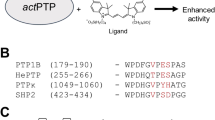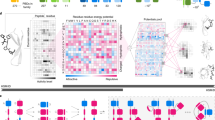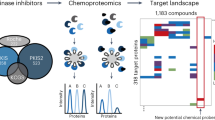Abstract
Signal transduction cascades involve multiple enzymes and are orchestrated by selective protein–protein interactions that are essential for the progression of intracellular signaling events. Modulators of these protein–protein interactions have been used to dissect the role of individual components of each signaling cascade. We describe several methods that have been developed for the identification of pep-tides that inhibit the interaction between signaling proteins and hence selectively modulate their functions. Such peptide modulators provide important tools for basic research and have great potential as leads for the development of new classes of therapeutic drugs.
This is a preview of subscription content, access via your institution
Access options
Subscribe to this journal
Receive 12 print issues and online access
$209.00 per year
only $17.42 per issue
Buy this article
- Purchase on Springer Link
- Instant access to full article PDF
Prices may be subject to local taxes which are calculated during checkout
Similar content being viewed by others
References
Pawson, T. and Scott, J.D. 1997. Signaling through scaffold, anchoring, and adaptor proteins. Science 278: 2075–2080.
Hubbard, M.J. and Cohen, P. 1993. On target with a new mechanism for the regulation of protein phosphorylation. TIBS 18: 172–177.
Mochly-Rosen, D., Smith, B.L., Chen, C.H., Disatnik, M.H. and Ron, D. 1995. Interaction of protein kinase C with RACK1, a receptor for activated C-kinase: a role in beta protein kinase C mediated signal transduction. Biochem. Soc. Trans. 23: 596–600.
Koch, W.J., Inglese, J., Stone, W.C. and Lefkowitz, R.J. 1993. The binding site for the beta gamma subunits of heterotrimeric G proteins on the beta-adrenergic receptor kinase. J. Biol. Chem. 268: 8256–8260.
Pitcher, J.A., Inglese, J., Higgins, J.B., Arriza, J.L., Casey, P.J., Kim, C. et al. 1992. Role of βγ subunits of G proteins in targeting the b-adrenergic receptor kinase to membrane-bound receptors. Science 257: 1264–1267.
Boekhoff, I., Inglese, J., Schleicher, S., Koch, W.J., Lefkowitz, R.J. and Breer, H. 1994. Olfactory desensitization requires membrane targeting of receptor kinase mediated by beta gamma-subunits of heterotrimeric G proteins. J. Biol. Chem. 269: 37–40.
Scott, J.K. and Smith, G.P. 1990. Searching for peptide ligands with an epitope library. Science 249: 386–390.
Wu, J., Ma, Q.N. and Lam,K.S. 1994. Identifying substrate motifs of protein kinases by a random library approach. Biochemistry 33: 14825–14833.
Nishi, T., Budde,R.J., McMurray, J.S., Obeyesekere, N.U., Safdar, N., Levin, V.A. et al. 1996. Tight-binding inhibitory sequences against pp60(c-src) identified using a random 15-amino-acid peptide library. FEBS Lett 399: 237–240.
Nevalainen, L.T., Aoyama, T., Ikura, M., Crivici, A., Yan, H., Chua, N.H. et al. 1997 Characterization of novel calmodulin-binding peptides with distinct inhibitory effects on calmodulin-dependent enzymes. Biochem. J. 321: 107–115.
Fantl, W.J., Escobedo, J.A., Martin, G.A., Turck, C.W., del Rosario, M., McCormick, F. et al. 1992. Distinct phosphotyrosines on a growth factor receptor bind to specific molecules that mediate different signaling pathways. Cell 69: 413–423.
Alonso, G., Koegl, M., Mazurenko, N. and Courtneidge, S.A. 1995. Sequence requirements for binding of Src family tyrosine kinases to activated growth factor receptors. J. Biol. Chem. 270: 9840–9848.
Wange, R.L., Isakov, N., Burke, T.R.Jr., Otaka, A., Roller, P.P., Watts, J.D. et al. 1995. F2(Pmp)2-TAM zeta 3, a novel competitive inhibitor of the binding of ZAP- 32. 70 to the T cell antigen receptor, blocks early T cell signaling. J. Biol. Chem. 270: 944–948.
Songyang, Z., Shoelson,S.E., Chaudhuri, M., Gish, G., Pawson, T., Haser,W.G. et al. 1993. SH2 domains recognize specific phosphopeptide sequences. Cell 72: 767–778.
Yaffe, M.B., Rittinger, K., Volinia, S., Caron, P.R., Aitken, A., Leffers,H. et al.1997. The structural basis for 14-3-3:phosphopeptide binding specificity. Cell 91: 961–971.
Songyang, Z., Fanning, A.S., Fu, C., Xu,J., Marfatia, S.M., Chishti, A.H et al. 1997. Recognition of unique carboxyl-terminal motifs by distinct PDZ domains. Science 275: 73–77.
Grabs, D., Slepnev, V.I., Songyang, Z., David, C., Lynch, M., Cantley, L.C. et al. 1997. The SH3 domain of amphiphysin binds the proline-rich domain of dynaminat a single site that defines a new SH3 binding consensus sequence. J. Biol. Chem. 272: 13419–13425.
Nishikawa, K., Toker, A., Johannes, F.J., Songyang, Z., and Cantley, L.C. 1997. Determination of the specific substrate sequence motifs of protein kinase C isozymes. J. Biol. Chem. 272: 952–960.
Rickles, R.J., Botfield, M.C., Zhou, X.M., Henry, P.A., Brugge, J.S., and Zoller, M.J. 1995. Phage display selection of ligand residues important for Src homolo-gy 3 domain binding specificity. Proc. Natl. Acad. Sci. USA 92: 10909–10913.
Schmitz, R., Baumann, G. and Gram, H. 1996. Catalytic specificity of phospho-tyrosine kinases Blk, Lyn, c-Src and Syk as assessed by phage display. J. Mol. Biol. 260: 664–677.
Alexandropoulos, K., Cheng, G. and Baltimore, D. 1995. Proline-rich sequencesthat bind to Src homology 3 domains with individual specificities. Proc. Natl. Acad. Sci. USA 92: 3110–3114.
Stauffer, T.R., Martenson, C.H., Rider, J.E., Kay, B.K., and Meyer, T. 1997. Inhibition of Lyn function in mast cell activation by SH3 peptides. Biochemistry 36: 9388–9394.
Carr, D.W., Hausken, Z.E., Fraser, I.D., Stofko-Hahn, R.E., and Scott, J.D. 1992. Association of the type II cAMP-dependent protein kinase with a human thyroid Rll-anchoring protein. Cloning and characterization of the Rll-binding domain. J. Biol. Chem. 267: 13376–13382.
Hirsch, A.H., Glantz,S.B., Li, Y., You,Y., and Rubin, C.S. 1992. Cloning and expression of an intron-less gene for AKAP 75, an anchor protein for the regulatory subunit of cAMP-dependent protein kinase II beta. J. Biol. Chem. 267: 2131–2134.
Carr, D.W., Stofko-Hahn, R.E., Fraser, I.D., Cone, R.D., and Scott, J.D. 1992. Localization of the cAMP-dependent protein kinase to the postsynaptic densities by A-kinase anchoring proteins. Characterization of AKAP 79. J. Biol. Chem. 267: 16816–16823.
Lester, L.B., Langeberg, L.K., and Scott, J.D. 1997. Anchoring of protein kinase A facilitates hormone-mediated insulin secretion. Proc. Natl. Acad. Sci. USA 94: 14942–14947.
Vijayaraghavan, S., Goueli, S.A., Davey, M.P., and Carr, D.W. 1997. Protein kinase A-anchoring inhibitor peptides arrest mammalian sperm motility. J. Biol. Chem. 272: 4747–4752.
Rosenmund C., Carr, D.W., Bergeson, S.E., Nilaver, G., Scott, J.D., and Westbrook, G.L 1994. Anchoring of protein kinase A is required for modulation of AMPA/kainate receptors on hippocampal neurons. Nature 368: 853–856.
Aitken, A., Ellis, C.A., Harris, A., Sellers, L.A., and Toker, A. 1990. Kinase and neu-rotransmitters [letter]. Nature 344: 594.
Mochly-Rosen, D., Khaner, H., and Lopez, J. 1991. Identification of intracellular receptor proteins for activated protein kinase C. Proc. Natl. Acad. Sci. USA 88: 3997–4000.
Ron, D. and Mochly-Rosen, D. 1994. Agonists and antagonists of protein kinase C function, derived from its binding proteins. J. Biol. Chem. 269: 21395–21398.
Mochly-Rosen, D., Miller, K.G., Scheller, R.H., Lopez, J., and Smith, B.L. 1992. p65 fragments, homologous to the C2 region of protein kinase C, bind to the intracellular receptors for protein kinase C. Biochemistry 31: 8120–8124.
Disatnik, M.H., Hernandez-Sotomayor, S.M., Jones, G., Carpenter, G., and Mochly-Rosen, D. 1994. Phospholipase C-gamma 1 binding to intracellular receptors for activated protein kinase C. Proc. Natl. Acad. Sci. USA 91: 559–563.
Ron, D., Luo, J., and Mochly-Rosen, D. 1995. C2 region-derived peptides inhibit translocation and function of beta protein kinase C in vivo. J. Biol. Chem. 270: 24180–24187.
Yedovitzky, M., Mochly-Rosen, D., Johnson, J.A., Gray, M.O., Ron, D., Abramovitch, E. et al. 1997. Translocation inhibitors define specificity of protein kinase C isoenzymes in pancreatic beta-cells. J. Biol. Chem. 272: 1417–1420.
Zhang, Z.H., Johnson, J.A., chen, L., El-Sherif, N., Mochly-Rosen, D., and Boutjdir, M. 1997. C2 region-derived peptides of beta-protein kinase C regulate cardiac Ca2+ channels. Circ. Res. 80: 720–729.
Johnson, J.A., Gray, M.O., Chen, C.H., and Mochly-Rosen, D. 1996. A protein kinase C translocation inhibitor as an isozyme-selective antagonist of cardiac function. J. Biol. Chem. 271: 24962–24966.
Sossin, W.S. and Schwartz, J.H. 1993. Ca2+−independent protein kinase Cs contain an amino-terminal domain similar to the C2 consensus sequence. TIBS 18: 207–208.
Gray, M.O., Karliner, J.S., and Mochly-Rosen, D. 1997. A selective epsilon-pro-tein kinase C antagonist inhibits protection of cardiac myocytes from hypoxia-induced cell death. J. Biol. Chem. 272: 30945–30951.
Kobe, B., Heierhorst, J., and Kemp, B.E. 1997. Intrasteric regulation of protein kinases. Adv. Second Messenger Phosphoprotein Res. 31: 29–40.
Ron, D., Chen, C.H., Caldwell, J., Jamieson L., Orr, E., and Mochly-Rosen, D. 1994. Cloning of an intracellular receptor for protein kinase C: a homolog of the beta subunit of G proteins Proc. Natl. Acad. Sci. USA 91: 839–843.[published erratum appears 1995, Proc. Natl. Acad. Sci. USA 92:2016.
Ron, D. and Mochly-Rosen, D. 1995. An autoregulatory region in protein kinase C: the seudoanchoring site. Proc. Natl. Acad. Sci. USA 92: 492–496.
Johnson, J.A., Gray, M.O., Karliner, J.S., Chen, C.H., and Mochly-Rosen, D. 1996. An improved permeabilization protocol for the introduction of peptides into cardiac myocytes. Application to protein kinase C research. Circ. Res. 79: 1086–1099.
O'Brian, C.A., Ward, N.E., Liskamp, R.M., de Bont, D., Earnest, L.E., van Boom, J.H. et al. 1991. A novel N-myristylated synthetic octapeptide inhibits protein kinase C activity and partially reverses murine fibrosarcoma cell resistance to adriamycin. Inest. New Drugs 9: 169–179.
Verhoeven, A.J., Leusen, J.H., Kessels, G.C., Hilarius, P.M., de Bont, D.B., and Liskamp, R.M. 1993. Inhibition of neutrophil NADPH oxidase assembly by a myristoylated pseudosubstrate of protein kinase C. J. Biol. Chem. 268: 18593–18598.
Theodore, L., Derossi, D., Chassaing, G., Llirbat, B., Kubes, M., Jordan, P. et al. 1995. Intraneuronal delivery of protein kinase C pseudosubstrate leads to growth cone collapse. J. Neurosci. 15: 7158–7167.
Derossi, D., Joliot, A.H., Chassaing, G., and Prochiantz, A. 1994. The third helixof the Antennapedia homeodomain translocates through biological membranes. J. Biol. Chem. 269: 10444–10450.
Mochly-Rosen, D., Khaner, H., Lopez, J., and Smith, B.L. 1991. Intracellular receptors for activated protein kinase C. Identification of a binding site for the enzyme. J.Biol. Chem. 266: 14866–14868.
Prochiantz, A. 1998. Peptide nucleic acid smugglers. Nat. Biotechnol. 16: 819–820.
Pooga, M., Soomets, U., Hallbrink, M., Valkna, A., Saar, K., Rezaei, K. et al. 1998. Cell penetrating PNA constructs regulate galanin receptor levels and modify pain transmission in vivo. Nat. Biotechnol. 16: 857–861.
Author information
Authors and Affiliations
Rights and permissions
About this article
Cite this article
Souroujon, M., Mochly-Rosen, D. Peptide modulators of protein–protein interactions in intracellular signaling. Nat Biotechnol 16, 919–924 (1998). https://doi.org/10.1038/nbt1098-919
Received:
Accepted:
Issue Date:
DOI: https://doi.org/10.1038/nbt1098-919
This article is cited by
-
Targeting an allosteric site in dynamin-related protein 1 to inhibit Fis1-mediated mitochondrial dysfunction
Nature Communications (2023)
-
A selective inhibitor of mitofusin 1-βIIPKC association improves heart failure outcome in rats
Nature Communications (2019)
-
Enhanced immunocompatibility of ligand-targeted liposomes by attenuating natural IgM absorption
Nature Communications (2018)
-
Oxidized Carbon Black: Preparation, Characterization and Application in Antibody Delivery across Cell Membrane
Scientific Reports (2018)
-
Interaction of mitochondrial fission factor with dynamin related protein 1 governs physiological mitochondrial function in vivo
Scientific Reports (2018)



